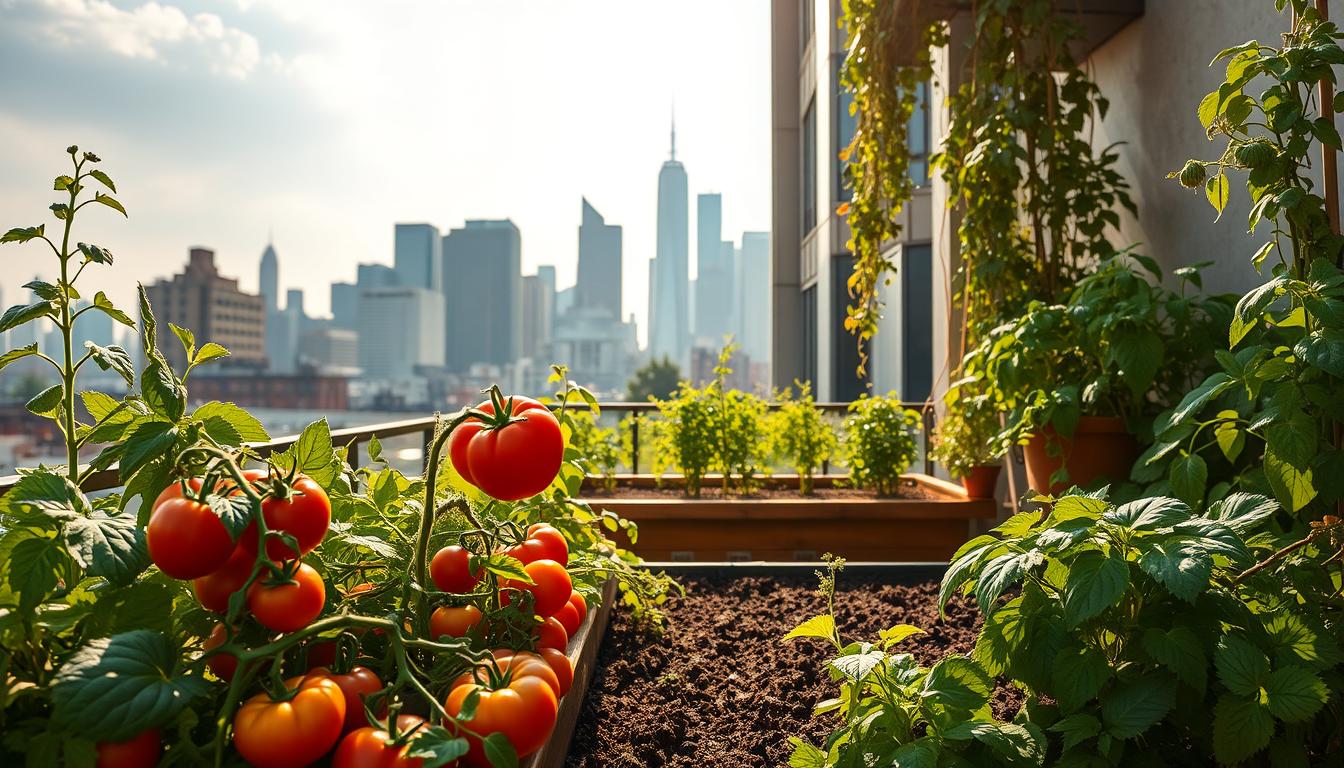
The Beginner’s Guide to Container Gardening: Grow Anything, Anywhere!
Can you grow a lush garden in a small balcony or a tiny backyard? Yes, you can! With small space gardening, you can enjoy fresh produce and beautiful flowers even in the most unlikely spaces.
Welcome to the world of urban gardening, where creativity meets sustainability. This beginner’s guide will show you how to create a thriving garden in containers. It’s perfect for urban areas or balconies.
You’ll learn how to make the most of your space. Enjoy the benefits of gardening, from fresh air to homegrown produce.
What is Container Gardening?
Container gardening changes how we grow plants. It’s a flexible way to grow many types of plants. Instead of planting in the ground, you use containers.
Definition and Benefits
Container gardening means growing plants in pots, not in the ground. It has many benefits. For example, it lets you control the soil and drainage better.
This leads to healthier plants. Plus, you can move plants around easily. This is great for balcony gardening and indoor plants where space is tight.
| Benefits | Description | Applicability |
|---|---|---|
| Improved Soil Quality | Control over soil composition | All container gardens |
| Better Drainage | Prevents waterlogged soil | Container vegetable gardening, indoor plants |
| Increased Flexibility | Move plants as needed | Balcony gardening, indoor plants |
Types of Container Gardens
Container gardens come in many styles. You can have simple herb planters or big vertical gardens. You can pick from pots, planters, or hanging baskets.
Container vegetable gardening is popular. It lets you grow veggies in small spaces. Indoor plants also do well in containers, adding green to homes and offices.
Container gardening is for everyone. Whether you’re new to gardening or have lots of experience, you can make a beautiful garden. Just pick the right containers and plants.
Choosing the Right Containers
The key to a stunning container garden is picking the right containers. It’s not just about looks; it affects your plants’ health and growth.
Materials for Containers
Containers are made from different materials, each with its own benefits and drawbacks. Plastic containers are light and easy to move but may not last as long. Clay or terracotta pots look natural and let soil breathe, preventing waterlogged soil. Yet, they’re heavy and can crack in cold weather. Wooden containers bring a rustic feel and can last long if treated right.
Sizes and Shapes to Consider
The size and shape of your containers depend on your plants and space. Big containers support deep roots and need less water. Small ones are perfect for herbs and small plants. The shape affects plant growth; deep containers are best for plants with deep roots.
Drainage Considerations
Good drainage stops waterlogged soil and root rot. Containers need holes for water to drain. Adding gravel or broken pottery at the bottom helps keep soil dry and aerated.
Thinking about material, size, shape, and drainage makes your container garden thrive. It boosts your garden design and supports vertical gardening.
Ideal Plants for Container Gardening
Container gardening is great for growing many types of plants. Think about sunlight, water, and temperature when picking plants. This helps your garden stay healthy and grow well.
Herbs and Vegetables
Container gardening is perfect for growing herbs and veggies. You can have fresh lettuce, kale, basil, mint, cherry tomatoes, and peppers right in your kitchen. Just make sure they get enough sunlight and water.
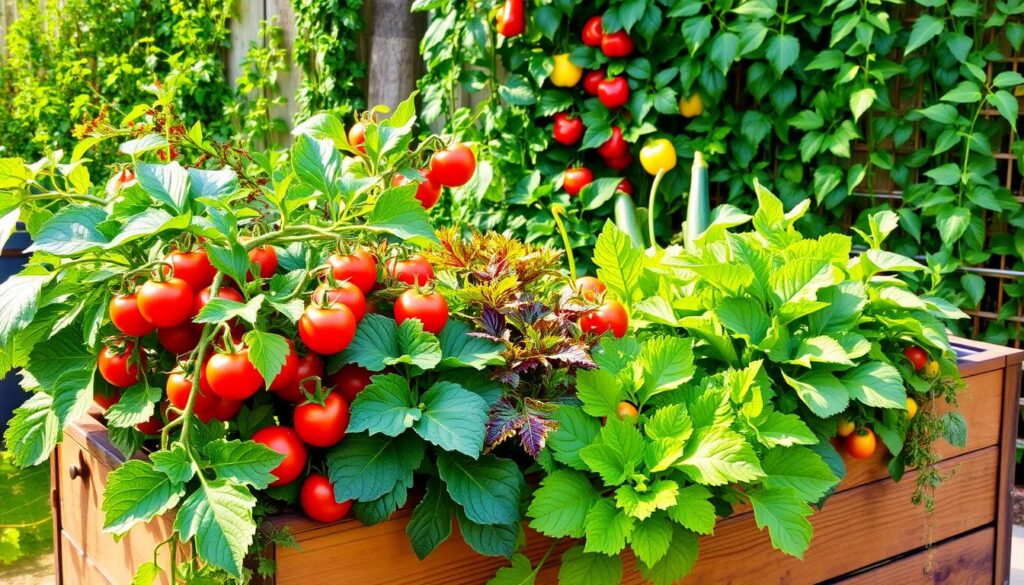
For edibles, use containers that are 5-7 gallons. This gives the roots enough room. Make sure the containers have good drainage to avoid soggy soil.
| Plant | Container Size | Sunlight Needs |
|---|---|---|
| Basil | 5 gallons | Full Sun |
| Cherry Tomatoes | 7 gallons | Full Sun |
| Lettuce | 3 gallons | Partial Shade |
Flowers and Ornamentals
Container gardens are also great for flowers and ornamentals. Petunias, geraniums, and begonias are popular. They look good and are easy to care for. They can handle different amounts of sunlight.
Succulents and Cacti
Succulents and cacti are perfect for small spaces or tough gardening spots. They need little water and care. They come in many shapes, sizes, and colors. They’re great for adding green to your home.
Soil and Fertilization Basics
For a successful small space garden, understanding soil and fertilization is key. The right mix of soil and fertilizers is vital. They give plants the nutrients they need to grow well.
Best Types of Soil for Containers
In container gardening, the soil type matters a lot. Unlike yard soil, a good potting mix holds moisture but drains excess water. This prevents root rot.
A top-notch potting mix drains well and has organic matter. This matter keeps moisture and nutrients. Peat-based mixes and soilless mixes are favorites for container gardens.
Fertilizers: When and How to Use Them
Fertilizers add vital nutrients missing in potting mix. Balanced fertilizers (like 20-20-20 NPK) are a solid start. But, the right fertilizer and amount depend on the plant and its growth stage.
Here’s a look at different fertilizers and their uses:
| Fertilizer Type | N-P-K Ratio | Usage |
|---|---|---|
| Balanced Fertilizer | 20-20-20 | General use for most plants |
| High Phosphorus Fertilizer | 15-30-15 | Promotes blooming and root development |
| Slow Release Fertilizer | Varies | Provides nutrients over an extended period |
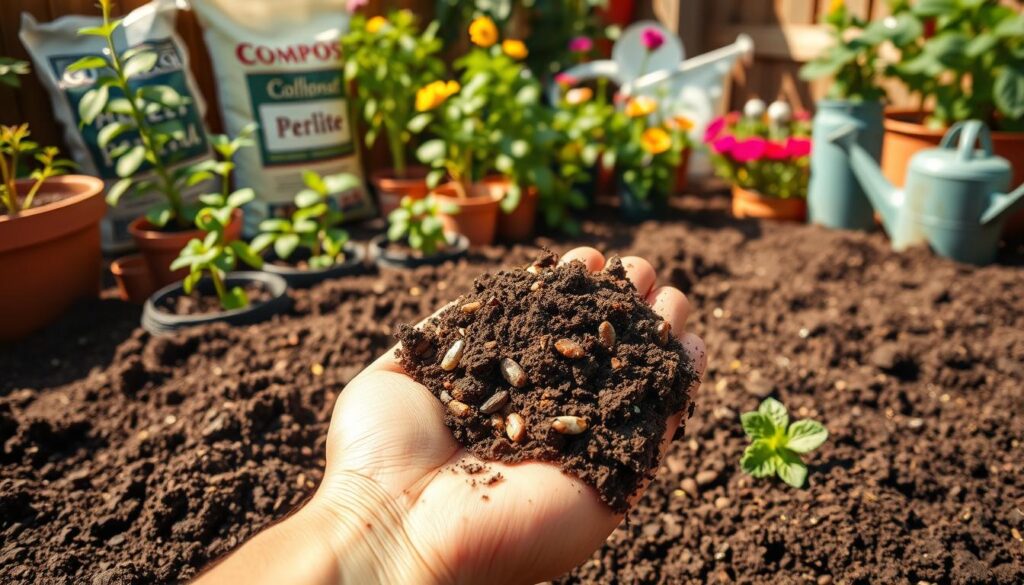
By picking the right soil and fertilizers wisely, you can make a container garden thrive. It will add joy and freshness to your small space or urban garden.
Watering Your Container Garden
Getting the right amount of water is key for a thriving container garden. Whether you’re gardening on a balcony or creating a complex garden design, knowing how to water is essential.
Watering is more than just giving plants enough water. It’s about doing it in a way that helps them grow well. How often and how you water can greatly affect your garden’s health.
Signs of Underwatering and Overwatering
It’s important to know the signs of underwatering and overwatering. Underwatering can stress plants, causing wilted leaves and slow growth. Overwatering can rot roots and kill plants.
Common signs of underwatering include: dry soil, wilted leaves, and slow growth. Signs of overwatering include yellow leaves, soft stems, and mold or mildew.
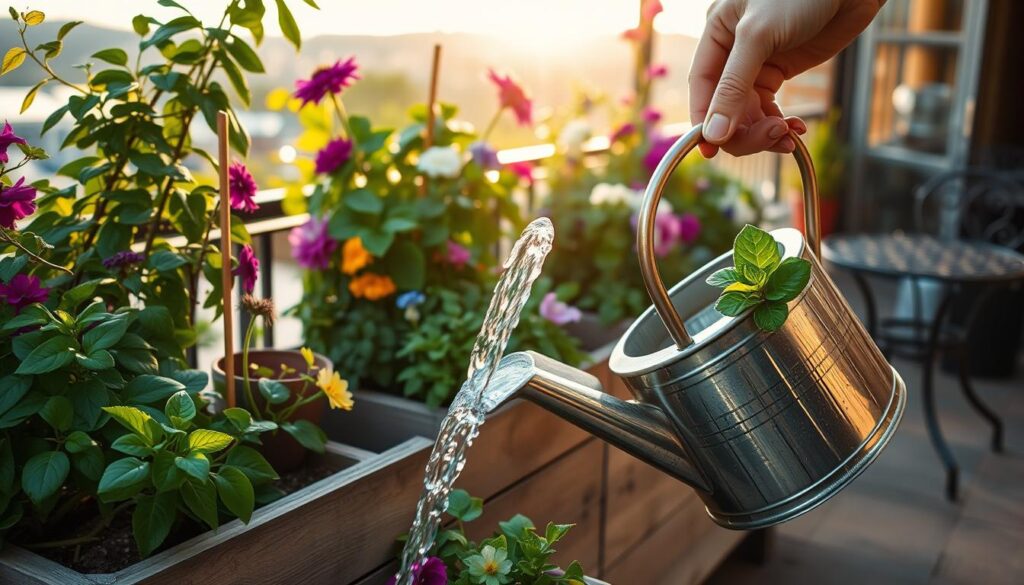
Best Watering Practices
Good watering practices can greatly improve your garden’s health. Watering in the morning helps plants absorb water all day. This reduces the chance of fungal diseases that thrive in wet conditions at night.
Using drip irrigation or a soaker hose is also effective. These methods water plants at their roots, cutting down on evaporation and runoff.
| Watering Method | Benefits | Best For |
|---|---|---|
| Morning Watering | Reduces risk of fungal diseases, allows plants to absorb water throughout the day | Most plants, including those prone to fungal diseases |
| Drip Irrigation | Delivers water directly to roots, minimizes evaporation and runoff | Plants that need steady moisture, like vegetables and herbs |
| Soaker Hose | Efficiently waters plants without wetting foliage, reducing disease risk | Garden beds and containers with many plants |
Light Requirements for Container Gardens
Light is crucial in container gardening. It greatly affects your plants’ success. Each plant has its own light needs, so it’s important to know what they are.
Understanding Sunlight Needs
Most plants need sunlight to grow. Indoor plants might need extra light, like from a sunny window. Knowing what light your plants need is key.
Some plants, like succulents, need lots of sun. Others, like ferns, prefer shade. Find out what each plant needs to place them right.
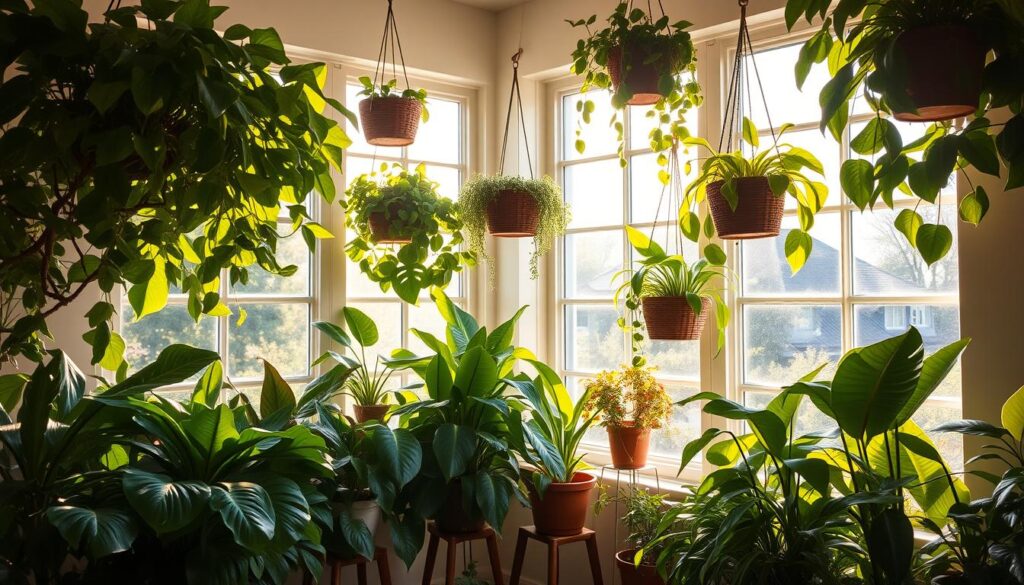
Placement Tips for Optimal Growth
After knowing what light your plants need, place them wisely. For outdoor gardens, think about the sun direction and timing.
For vertical gardening or indoor gardens, grow lights can help. They’re great for when there’s little natural light, like in winter. This ensures your plants get enough light to grow well.
By thinking about light needs and placing plants carefully, you can create a great growing space for them.
Seasonal Gardening Tips
Seasonal changes open up new ideas for garden ideas and container vegetable gardening. To get the most from your container garden, plan with the season in mind. Pick plants that do well in the current weather.
Planning for Spring and Summer
Spring and summer are perfect for growing warm-season crops like tomatoes, peppers, and eggplants. These plants need lots of sunlight and warmth to grow well. Use self-watering containers or moisture-retentive potting mixes to handle the heat and dryness.
Fall and Winter Container Gardening
In fall and winter, grow cool-season crops like kale, spinach, and broccoli. These plants like cooler weather and can handle light frosts. To keep your plants safe from harsh winter, use frost blankets or bring containers under cover when it’s very cold.
Fall and winter are also great for ornamental plants like pansies, cyclamen, and ornamental kale. They add color and interest to your garden during the cooler months.
Pest Management in Container Gardens
Container gardens, though small, can attract pests. This means gardeners need good strategies to manage them. Even the most careful gardeners can face pests in their urban or small space gardens.
Common Pests and Solutions
Aphids, spider mites, and mealybugs are common pests in container gardens. Aphids are small, soft insects that spread disease and slow plant growth. They can be controlled with neem oil or insecticidal soap.
Spider mites are tiny, spider-like insects that turn leaves yellow or bronze. To control them, increase the plants’ humidity and use miticides if needed.
Mealybugs look like white, cottony patches on plants. Treat them by isolating the plants and applying insecticidal soap.
Preventative Measures and Best Practices
Prevention is key in managing pests in container gardens. Regularly check your plants for pests like eggs, actual insects, or damage.
Keeping your garden clean is also important. Remove weeds, get rid of infested plants, and ensure good air flow around your garden.
Using physical barriers, like fine mesh, can keep pests away from your plants. Also, encourage beneficial insects like ladybugs and lacewings to naturally control pests.
Troubleshooting Your Container Garden
Even with the best care, container gardens can face problems. Whether you’re gardening on your balcony or patio, it’s key to spot and fix issues quickly.
Identifying Common Issues
Problems like yellow leaves, slow growth, and pests are common. Check if your soil is too wet or dry, if your plants get enough sunlight, and if you’re fertilizing them right. Making these adjustments can often fix the issue.
If you’re having trouble with water, try using a mix that drains well. This can help your plants stay healthy.
Knowing When to Seek Help
If you’ve checked the basics and your plants still struggle, it’s time to get expert advice. A local nursery or gardening expert can offer tailored advice on garden design. They can also help solve more complex problems.
By troubleshooting well, you can keep your garden in top shape. And you’ll enjoy a beautiful outdoor space.
FAQ
What is the best type of soil for container gardening?
Use a high-quality potting mix made for containers. Don’t use garden soil from your yard. It can make the soil too dense and block water.
How often should I water my container garden?
Check the soil often. Water when the top inch feels dry. Don’t water too much to avoid root rot.
Can I grow vegetables in containers on a balcony?
Yes, many veggies do well in containers on balconies. Pick compact or dwarf varieties. Make sure they get enough sunlight and water.
How can I prevent pests in my container garden?
Regularly check your plants for pests. Keep things clean. Use neem oil or insecticidal soap to stop pests.
What are some good plants for indoor container gardening?
Succulents, cacti, and low-light herbs like basil or mint are great. They do well indoors with the right care.
Can I use any container for gardening?
You can use many containers, but make sure they have holes for drainage. Think about the material, size, and shape for your plants.
How much sunlight do container gardens need?
Plants need different amounts of sunlight. Find out what your plants need. Some like partial shade, others need full sun.
Can I fertilize my container garden?
Yes, fertilizers are good for your plants. Use them carefully, following the instructions to avoid too much.
How do I troubleshoot common issues in my container garden?
First, figure out the problem. Then, look up possible causes and change your care routine. If you’re still stuck, ask a gardening expert for help.
Leave a Reply